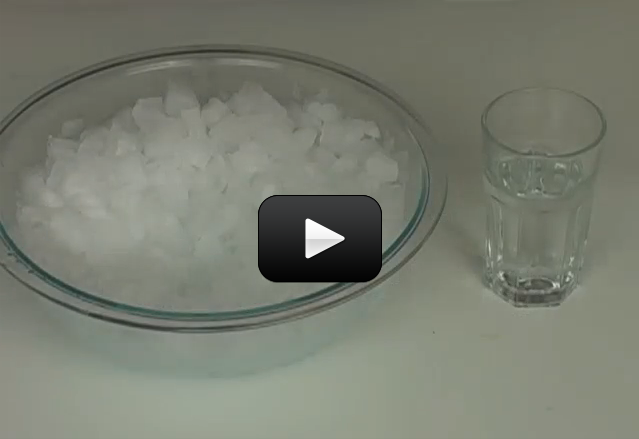Supercooling a liquid is a really neat way of keeping the liquid a liquid below the freezing temperature. Normally, when you decrease the temperature of water below 32oF, it turns into ice. But if you do it gently and slowly enough, it will stay a liquid, albeit a really cold one!
In nature, you’ll find supercooled water drops in freezing rain and also inside cumulus clouds. Pilots that fly through these clouds need to pay careful attention, as ice can instantly form on the instrument ports causing the instruments to fail. More dangerous is when it forms on the wings, changing the shape of the wing and causing the wing to stop producing lift. Most planes have de-icing capabilities, but the pilot still needs to turn it on.
We’re going to supercool water, and then disturb it to watch the crystals grow right before our eyes! While we’re only going to supercool it a couple of degrees, scientists can actually supercool water to below -43oF!
Please login or register to read the rest of this content.


Those are great questions! I would test different amounts of each to see which works best!
Hi, How much salt should be used? What’s the salt to crushed ice ratio? Thanks!
I think the problem they might be having is that they are not adding enough salt. The more salt you add, the colder it will get. That was the problem my son had when he tried it on his own the first time. Just remember to mix lots of salt together with that surrounding ice.
Be sure that you are using glass and not plastic for the cup. Be sure to use crushed ice, not full size ice cubes and be sure that the ice level is higher than the level of water in the glass. Double check all those factors and then try again. Good luck!
What are some of the reasons this might not work? We ran the experiment twice.
Complete water molecules (H2O) connect to each other by hydrogen bonds. This type of bond is much weaker than ion bonds or covalent bonds. Therefore the hydrogen bonds continually form and break as H2O molecules move around in liquid water. As the temperature of water is lowered, the speed of the water molecules slow down. This slower motion allows the hydrogen bonds to strengthen. They strengthen more and more until the molecules “lock” into a crystal structure. Thus forming ice.
Even when water is in a solid state, a certain amount of molecules move back and forth between a solid and liquid state.
When salt is introduced to water, the salt ions literally “get in the way” of some hydrogen bonds. This prevent crystals from re-forming. As water molecules move around, they lose heat. Since they can’t lock into place, they continue to slow down, which lowers the temperature below the normal freezing point. Eventually the water molecules slow to the point that the pull of a hydrogen bond is strong enough to overpower the resistance from the salt ion. The water molecules are then able to displace the salt ion and lock in to the crystal form.
Hello Aurora,
Can you please help us understand at a more detailed/ molecular level, what the salt actually does to make the water cool without freezing?
We researched that the water can super cool best with no impurities, but this is not the case here.
many thanks
You’re right – the image disappeared. I’ll see if I can find it to repost it – sorry about that. We just updated the website and it did a few strange things we’re still fixing.
The water for this experiment needs to be REALLY cold, like put it in the freezer for 20 minutes after spending the night in the coldest part of the fridge. If it’s near-freezing outside, you can also leave the cup outside overnight. You don’t need a thermometer, just a bit of patience and persistence with this particular experiment.
I don’t see an image below this lesson. If, after completing the experiment as directed, the water does not freeze after the 15 minutes what could cause this. We made sure there was no salt in the cup of water and the glass was carefully removed from the ice. We did the experiment twice with the same result. Unfortunately we do not have a laboratory thermometer to determine the exact temperature of the water during the experiment.